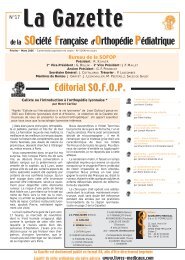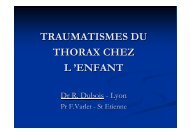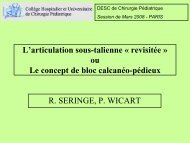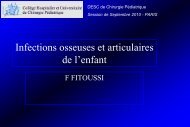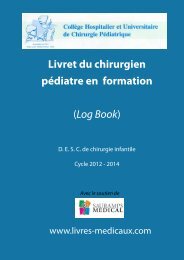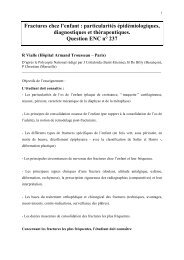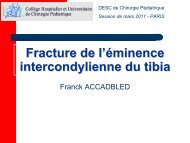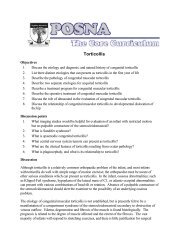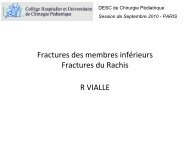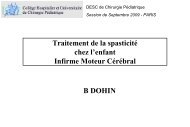Acute osteomyelitis - SOFOP
Acute osteomyelitis - SOFOP
Acute osteomyelitis - SOFOP
You also want an ePaper? Increase the reach of your titles
YUMPU automatically turns print PDFs into web optimized ePapers that Google loves.
<strong>Acute</strong> <strong>osteomyelitis</strong>Objectives1. Describe the pathology of acute <strong>osteomyelitis</strong>2. Describe the natural history of untreated acute <strong>osteomyelitis</strong>3. Discuss therapy for each stage of natural history of untreated acute <strong>osteomyelitis</strong>4. Describe the workup of a child with suspected acute <strong>osteomyelitis</strong>5. Describe the most common offending organism causing <strong>osteomyelitis</strong> in the prematureinfant, the neonate, the toddler, and the older child6. Discuss antibiotic management, including route and duration, for acute <strong>osteomyelitis</strong>7. Discuss laboratory tests useful for following the clinical course of acute <strong>osteomyelitis</strong>8. List conditions can clinically mimic acute <strong>osteomyelitis</strong>9. Describe the features of chronic recurrent multifocal <strong>osteomyelitis</strong> (CRMO)Discussion points1. What is the incidence of acute <strong>osteomyelitis</strong>? Which limbs are most often affected?2. What imaging studies are valuable for the child with early acute <strong>osteomyelitis</strong>?3. What findings would make one suspect <strong>osteomyelitis</strong> in the premature infant?4. What criteria are helpful for deciding when oral antibiotics would be appropriate? Howlong is treatment necessary?5. Are there any indications for surgical intervention for acute <strong>osteomyelitis</strong>? Why or whynot?Discussion<strong>Acute</strong> <strong>osteomyelitis</strong> is one of the most important conditions on a global basis that is treated by theorthopaedic surgeon. In Norway, the incidence is roughly 1/10,000 children per year; but insusceptible populations such as premature infants with other complications, children withmalignancies or juvenile arthritis on immunosuppressives, or malnourished children; the incidenceis higher. In the child, the primary site of infection is the metaphysis, where the blood flowbecomes sluggish in the capillary loops. The inflammatory response is identical to that observed inother anatomic areas, but the response is initially contained in metaphyseal bone, either in longbones or flat bones. Rarely, the epiphysis can be primarily infected. The cardinal signs of early<strong>osteomyelitis</strong> are soft tissue swelling and marked bony tenderness with voluntary guarding of theaffected limb. WBC with differential, sed rate, C reactive protein, and plain radiographs areinitially obtained, and technetium imaging is helpful if there is doubt about the diagnosis. Boneaspiration and blood cultures (preferably drawn during rising portion of temperature spike) are the
most initial valuable laboratory studies. Bone aspiration should not be delayed for imaging studies,as aspiration does not alter results of bone scanning. Ultrasound may be helpful in detecting andlocalizing subperiosteal abscess. MRI has been reported as the most helpful imaging modality fordiagnosis and localization of the inflammatory process in the earlier stages of the condition whenplain radiographs are not helpful (although soft tissue swelling is an early sign). When an abscesshas formed in the bone, pain is more severe; eventually the abscess will penetrate the thinmetaphyseal cortical bone, and can result in secondary septic arthritis, especially in the hip, elbow,and shoulder. For more complex diagnostic situations, indium and/or gallium scanning have beenadvocated. Photopenic scans indicate a more ominous prognosis.The natural history of acute <strong>osteomyelitis</strong> has been dramatically changed since the availability ofantibiotics, with a mortality rate of 25% in the preantibiotic era. If intravenous antibiotics specificfor the offending organism can be delivered to the bone before abscess formation has occurred, oreven if a small abscess has formed, a rapid clinical response is usually noted. In such a case,present thought allows administration of oral antibiotics when a clinical response has beenconfirmed, and the C reactive protein is dropping. A recent study from Finland concluded thatroutine bactericidal monitoring is not necessary when changing from intravenous to oralantibiotics, but Nelson, the originator of replacing intravenous antibiotics with oral, was notconvinced. 6 weeks of treatment has been standard, but recent studies have documented theeffectiveness of much shorter durations. However, if presentation is late, and/or devitalized bone isresponsible for a diminished response to antibiotic treatment, surgical intervention is oftennecessary. Since vaccination against hemophilus has been introduced, the incidence of<strong>osteomyelitis</strong> secondary to that organism has been markedly reduced.Childhood bony neoplasms such as osteosarcoma or Ewings, fractures in anesthetic limbs, juvenilearthritis, septic arthritis, and cellulitis are the most common conditions mimicking acute<strong>osteomyelitis</strong>.Chronic recurrent multifocal <strong>osteomyelitis</strong> is a rare systemic condition characterized by multiplesites of lytic defects of bone; with varying states of chronicity among various, often concomitantlesions. It is most prevalent between ages 5-15, and has a 2:1 female preponderance. Laboratoryvalues are generally normal. Long bones are most often affected. Treatment is symptomatic,nonsteriodals have been noted to afford some symptomatic relief. The bony lesions are sterile.Tuberculous infections still occur in many areas of the world. Delay in diagnosis is common. Ifthe growth plate is not affected, the prognosis from treatment is good.Osteomyelitis will have a constantly changing picture, as the balance between antibiotics, hostresistance, and the virulence of various organisms tips one way or the other. The clinician mustalways be alert to unusual presentations or infecting organisms.References1. Bowerman SG, Green NE, Mencio GA. Decline of bone and joint infections attributable tohaemophilus influenzae type b. Clinical Orthopaedics & Related Research 1997(341):128-33.2. Chen SC, Huang SC, Wu CT. Nonspinal tuberculous <strong>osteomyelitis</strong> in children. Journal ofthe Formosan Medical Association 1998;97(1):26-31.
3. Chow LT, Griffith JF, Kumta SM, Leung PC. Chronic recurrent multifocal <strong>osteomyelitis</strong>: agreat clinical and radiologic mimic in need of recognition by the pathologist. Apmis1999;107(4):369-79.4. Christiansen P, Frederiksen B, Glazowski J, Scavenius M, Knudsen FU. Epidemiologic,bacteriologic, and long-term follow-up data of children with acute hematogenous <strong>osteomyelitis</strong>and septic arthritis: a ten-year review. Journal of Pediatric Orthopaedics. Part B 1999;8(4):302-5.5. Dahl LB, Hoyland AL, Dramsdahl H, Kaaresen PI. <strong>Acute</strong> <strong>osteomyelitis</strong> in children: apopulation-based retrospective study 1965 to 1994. Scandinavian Journal of Infectious Diseases1998;30(6):573-7.6. Gylys-Morin VM. MR imaging of pediatric musculoskeletal inflammatory and infectiousdisorders. Magnetic Resonance Imaging Clinics of North America 1998;6(3):537-59.7. Handrick W, Hormann D, Voppmann A, Schille R, Reichardt P, Trobs RB, et al. Chronicrecurrent multifocal <strong>osteomyelitis</strong>--report of eight patients. Pediatric Surgery International1998;14(3):195-8.8. Kaiser S, Jorulf H, Hirsch G. Clinical value of imaging techniques in childhood<strong>osteomyelitis</strong>. Acta Radiologica 1998;39(5):523-31.9. Longjohn DB, Zionts LE, Stott NS. <strong>Acute</strong> hematogenous <strong>osteomyelitis</strong> of the epiphysis.Clinical Orthopaedics & Related Research 1995(316):227-34.10. Nelson JD. Toward simple but safe management of <strong>osteomyelitis</strong> [comment]. Pediatrics1997;99(6):883-4.11. Peltola H, Unkila-Kallio L, Kallio MJ. Simplified treatment of acute staphylococcal<strong>osteomyelitis</strong> of childhood. The Finnish Study Group [see comments]. Pediatrics 1997;99(6):846-50.12. Pennington WT, Mott MP, Thometz JG, Sty JR, Metz D. Photopenic bone scan<strong>osteomyelitis</strong>: a clinical perspective. Journal of Pediatric Orthopedics 1999;19(6):695-8.13. Perlman MH, Patzakis MJ, Kumar PJ, Holtom P. The incidence of joint involvement withadjacent <strong>osteomyelitis</strong> in pediatric patients. Journal of Pediatric Orthopedics 2000;20(1):40-3.14. Sadat-Ali M. The status of acute <strong>osteomyelitis</strong> in sickle cell disease. A 15-year review.International Surgery 1998;83(1):84-7.15. Sadat-Ali M, al-Umran K, al-Habdan I, al-Mulhim F. Ultrasonography: can it differentiatebetween vasoocclusive crisis and acute <strong>osteomyelitis</strong> in sickle cell disease? Journal of PediatricOrthopedics 1998;18(4):552-4.16. Trobs R, Moritz R, Buhligen U, Bennek J, Handrick W, Hormann D, et al. Changingpattern of <strong>osteomyelitis</strong> in infants and children. Pediatric Surgery International 1999;15(5-6):363-72.17. Wall EJ. Childhood <strong>osteomyelitis</strong> and septic arthritis. Current Opinion in Pediatrics1998;10(1):73-6.18. Wang MN, Chen WM, Lee KS, Chin LS, Lo WH. Tuberculous <strong>osteomyelitis</strong> in youngchildren. Journal of Pediatric Orthopedics 1999;19(2):151-5.




